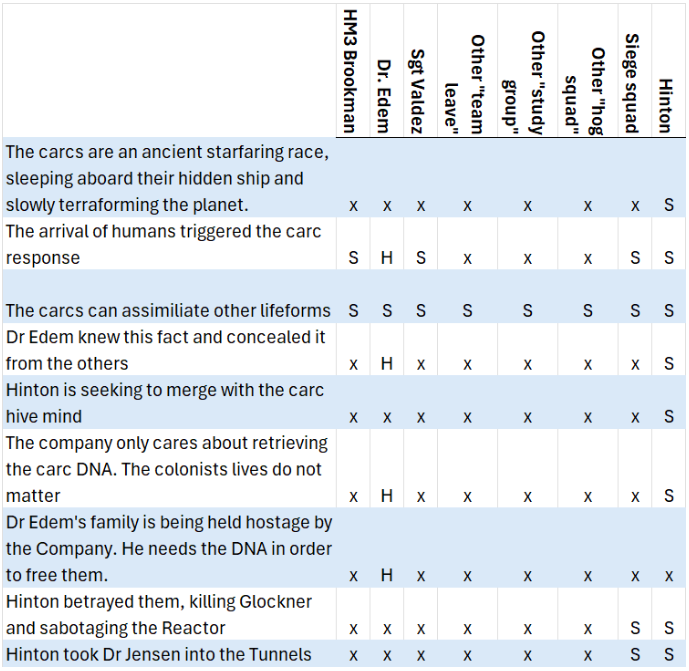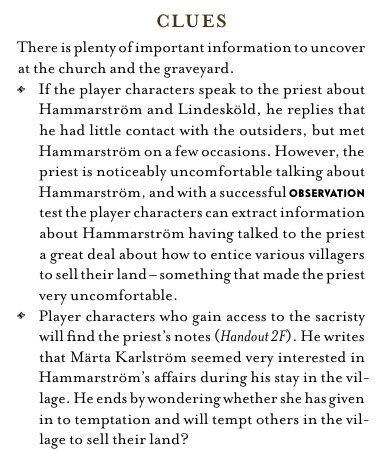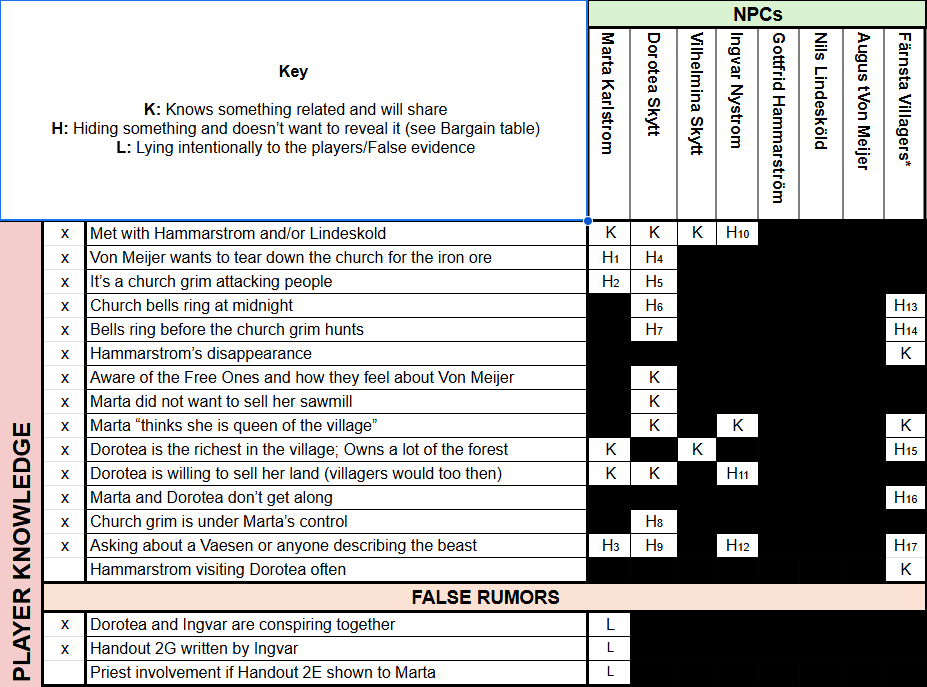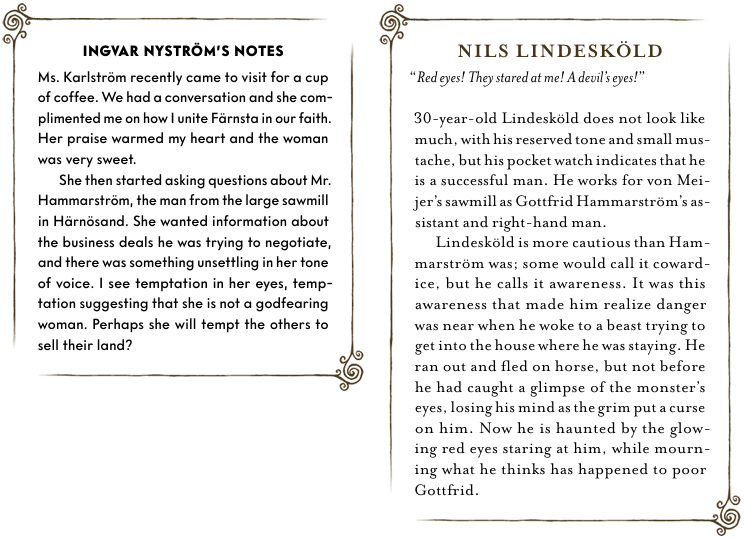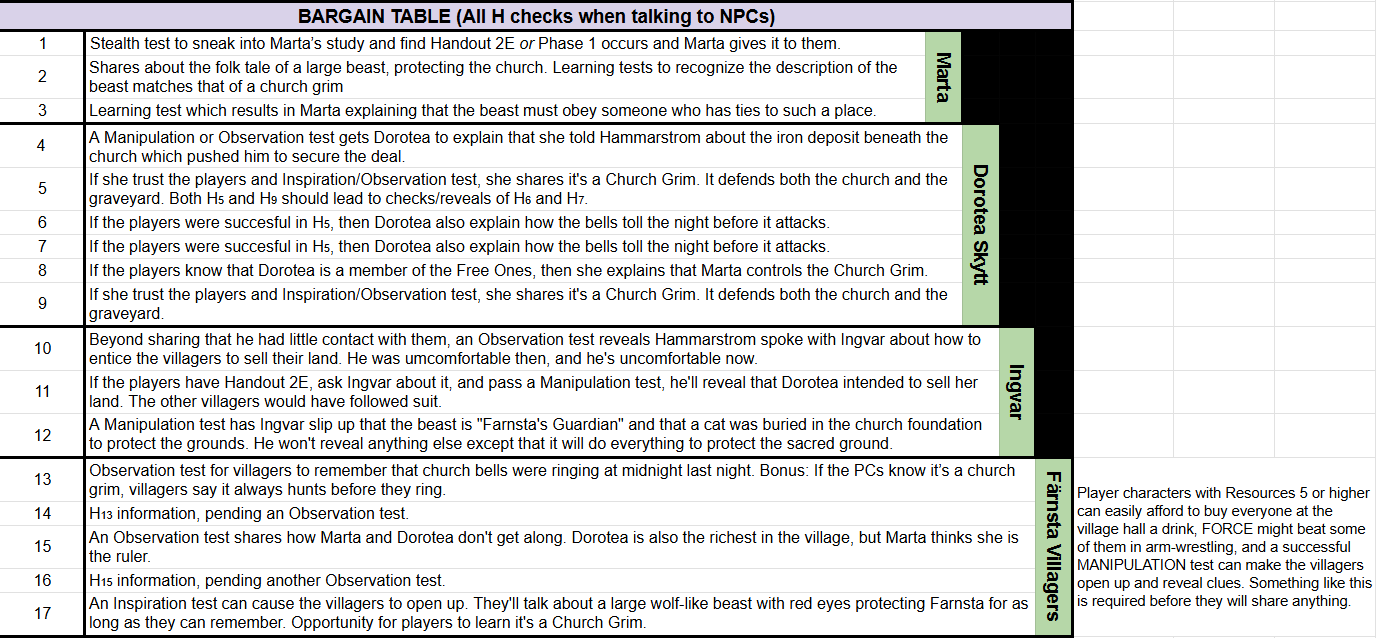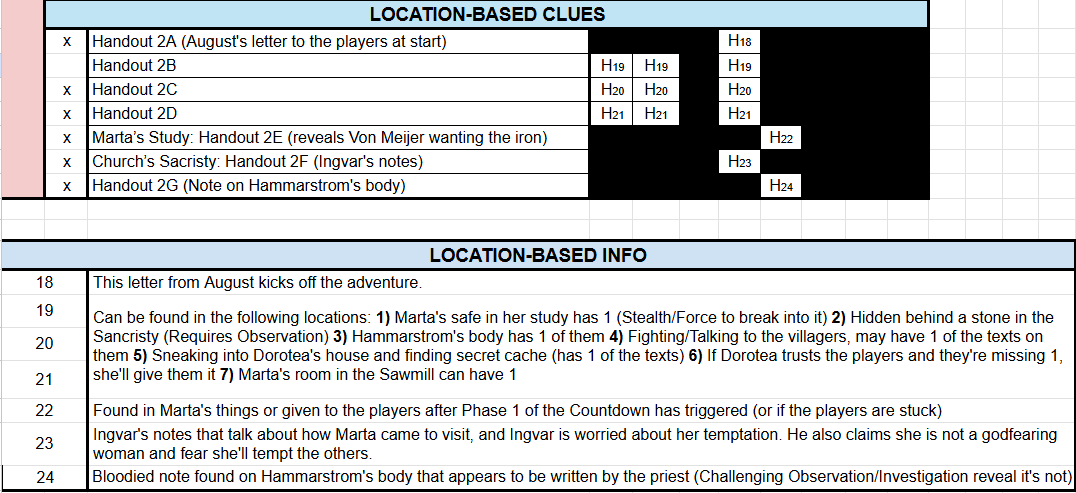Info Grids & Bargain Tables
Another Prep Tool
Note: This post includes spoilers for the adventures Another Bug Hunt and A Wicked Secret.
This is the first content, theory, or prep post I'm writing. The main thing is, it's not a Play Report. Rather, it's a deep-dive into a prep tool I found on The Novel Game Master's blog where they talked about creating a GM-facing aid to reference at the table during investigation-based adventures. That post uses Another Bug Hunt for Mothership as their example (see Figure 1).
Figure 1: The Info Grid example from The Novel Game Master blog.
I've taken the framework and extended it for A Wicked Secret in the Vaesen system. My version includes the following tables:
- Info Grid
- Bargain Table
- Location-Based Information
Creating the Info Grid
Expanding on the info grid above took a lot of work, because the layout and organization of A Wicked Secret is done by location rather than NPC. Within each location, the NPC knowledge, false rumors, and location-based clues are included all under a single location. This made it challenging to parse out what should go into my info grid and what should not. I decided that all NPC knowledge would be included as well as the rolls for acquiring the location-based clues. For example, one of the locations is The Church and the Graveyard. The location is outlined like this:
- The Church and the Graveyard
- Challenges
- Clues
Everything listed under the main heading are bullet points of clues/interactions that can occur. Along with this, both headings of Challenges and Clues include potential clues that are gained from a conversation with the priest, a notable NPC (see Figure 2). This meant if players spoke to the Priest briefly, left to go somewhere else in the village, and then come back, it would be challenging to keep track of the player knowledge. It also meant constant scrolling through a 32-page adventure of mostly text.
Figure 2: A couple clues in the Church for A Wicked Secret.
My first task then was to pull out every NPC knowledge check from each location (see Figure 3). I started by listing the NPCs included in the module. Next, I had to come up with the high level points of knowledge that the characters could discover from all these NPCs, something that made sense and/or would be required to solve the mystery at hand/kill the Vaesen. The most important part of this step was making sure my Key had no more than 3 entries, because keeping track of what the hell a letter K meant versus an L or some other letter felt like an added barrier to usage that I wanted to avoid. Due to the simplicity of the key and the information I pulled from the module, I was able to easily add False Rumors as an addendum to the info grid which was great when my players fell for some of these red herrings at first.
Figure 3: The Info Grid I created for NPC knowledge.
The last addition to the info grid was to add a Player Knowledge column on the left-hand side. As we progressed in each session, I was able to quickly mark off what players had uncovered and at a glance, I knew what pieces of the mystery they were missing.
Reading through the scenario, it's also unclear what sidebar textboxes are player-facing, GM-facing, or even flavor. Significant paragraphs of text march you through the setting, NPC goals, and location-based clues, while not providing quick access or reference to what players know and don't know (see Figure 4).
Figure 4: A couple clues in the Church for A Wicked Secret.
The image on the left-hand side of Figure 4 is a location-based clue that can be found by the players in the church aka player-facing, while the image on the right-hand side is a NPC overview that is GM-facing. The NPC overview not only reveals the type of Vaesen the players are hunting (a church grim), but it tells them what happened to Nils (cursed), one of the first NPCs the players encounter after being hired. In fact, when the players met Nils, I shared the image on the right and quickly had to delete after a re-read. Sure, you could argue that the headings are different as well as the font styling, but this is not consistent throughout the scenario.
Extending the Grid: Bargain Tables
Almost every investigation system I've played in requires the playrs to roll or do something to obtain NPC knowledge. Due to how much information was provided in A Wicked Secret, it made sense to create what I'm calling a Bargain Table. This listed out what players had to do to acquire the information they wanted on the Info Grid (see Figure 5).
Figure 5: The Bargain Table I created for A Wicked Secret.
Granted, this does not capture every roll possible when it comes to interacting with the NPCs, but again it's the high-level ones. Each H key in the Info Grid corresponds to an entry on the Bargain Table that allows a GM to quickly find what players need to do to acquire the knowledge. Creating this sub-table allowed me as a GM to get more into character and improv with the NPCs. When designing the table, I found that blocking them out by each NPC helped a great deal in keeping it organized. This is why the H keys in the Info Grid (see Figure 3) are numbered by each NPC rather than the information.
Further Expansion: Location-Based Clues
Beyond NPC knowledge, I mentioned there were both location-based clues and false rumors. The false rumors were easy to tack onto the bottom of the Info Grid. I did the same thing with the Location-Based Clues (see Figure 6).
Figure 6: The Location-Based Clues table for A Wicked Secret I created.
I took the same approach that I did with NPC knowledge except that H entries had to be keyed by the handout provided rather than the NPC that gives them out. Specifically, Handouts 2B-2D are the key to the players solving the mystery, which they can find in multiple locations. The scenario supports having you dole out these texts at various locations, which you can see listed in the Location-Based Info table.
Final Thoughts
Admittedly, I created all of this for a one-shot, and I was inspired by the blog post where I first saw the idea. I don't think I could have successfully run this scenario without an aid like this. There's too much information that's sprinkled throughout each location. This aid was a godsend for between sessions, because I could quickly look at the tables and anticipate what players were going to search/check next.
Oh, and on top of all this, there's also a Countdown clock in the background. Some rolls in the scenario are contingent upon what phase you're in. There were so few of these, though, that I did not find a clean, or viable, way to add them. I considered another colmun in the Info Grid that included which phase they could be acquired in, but this felt like bloat to an already expansive aid.
The bottom line is, I think investigation scenarios should include something like this as a reference. I wouldn't even mind it as a blank sheet that I then dig through the module to fill out. Either way, I know this scenario intimately thanks to creating this, so I was able to be more flexible when my characters did unexpected things. I'm looking forward to using it more in future investigation scenarios and am curious what y'all think about it as a staple reference in such modules.
